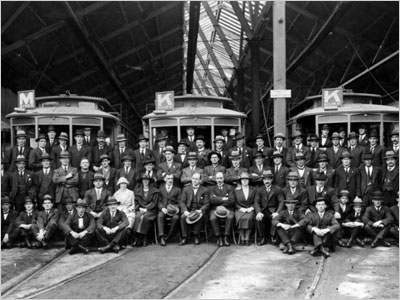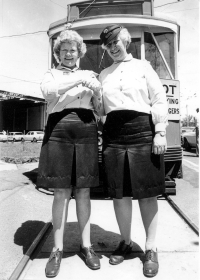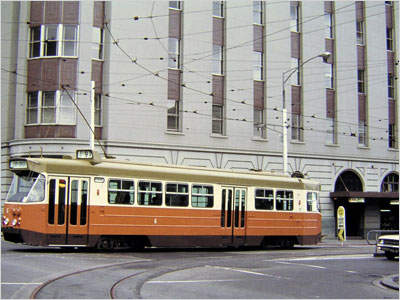Melbourne’s tram history
Melbourne's first electric tram began operation on 14 October 1889 between Box Hill and Doncaster. The service was abandoned less than seven years later and it took until October 1906 for another electric service to begin, this time operated by the private North Melbourne Electric Tramway and Lighting Company.
The Department of Planning and Community Development has also commissioned a Tram Heritage Study.
In the beginning
The tram began its life in industry as an aid to the transport of heavy loads, when miners discovered that it was easier to move a cart mounted on rails than to push it over uneven ground. Tramways spread through industry, the carts - or trams - sometimes pushed or pulled by manpower, sometimes drawn by horses.
As the industrial revolution continued, so did transport technology and, in 1869, a significant improvement on the horse tram was developed in San Francisco. English-born Andrew Hallidie, a manufacturer of steel wire rope, had an idea that the trams could be hauled more steadily and safely by a cable. Hallidie patented the inventions that made cable traction possible and the world's first cable tram system commenced operation in San Francisco in 1873.
This invention, and the progress of the San Francisco system, had been closely watched by an American transport entrepreneur and Melbourne businessman, Francis Boardman Clapp. Clapp set up the Melbourne Omnibus Company with William McCulloch and Henry Hoyt, bringing organised street public transport to Melbourne.

Scheduled services consisted of 11 horse-drawn buses taking passengers from the two City railway stations via Bourke Street to the Birmingham Hotel on the corner of Smith and Johnson Streets in Fitzroy. The three-penny fare was cheaper than a cab ride and soon services were operating to Richmond, Carlton and North Melbourne.
In 1877, Clapp bought the Victorian patents of Andrew Hallidie's inventions and changed the name of his company to the Melbourne Tramway & Omnibus Company.
Spurred on by tramways development overseas and the introduction of steam trams in Sydney, the colonial government in 1883 passed the Melbourne Tramway and Omnibus Act. Under this Act local councils whose streets would become part of the proposed network set up the Melbourne Tramways Trust to build tracks and powerhouses for the cable trams.
Meanwhile horse drawn tramways had began operating, with the first line carrying passengers from Fairfield Railway Station to Thornbury.
More horse tramways were introduced over the next few years at the time the first cable trams were being developed, but they were not widely adopted and ran only for short distances.
Around the growing city of Melbourne the construction of the cable system continued under a deal with would see it leased to the Melbourne Tramways & Omnibus Company to operate regular services until 1916.
Cable trams
Cable trams came in sets or 'trains' - the open 'dummy' at the front and the closed car behind. The dummy contained the 'grip' mechanism which attached or detached the tram set from the moving cable below the road. Melbourne's first tram cars were imported from New York but all later rolling stock was built at the company's workshop inNicholson Street, North Fitzroy.
The trams were small and light with room for 22 passengers seated inside and 34 standing. The dummies had seating for 20 and were licensed to carry 22 standing. Services were frequent, coming as often as every two minutes on the busiest lines at the busiest times.
Conductors collected fares using a bell punch. Fares paid were recorded not by issuing tickets to passengers but by punching a small hole in the long cardboard trip slips that the conductor pinned to his uniform. At the end of the day, the 'confetti' collected in the punch was counted to balance with the amount of money taken.
Melbourne's first cable tramway, the Spencer Street-Richmond line, ran from the corner of Bourke and Spencer Streets to Flinders Street, Wellington Parade and Bridge Road to the Hawthorn Bridge. It opened on 11 November 1885. The road had to be excavated to a depth of nearly four feet (1.2m) and tunnels constructed to house cables running in both directions.
Large steam engines powered a 24,870ft (7,580m) rope (as the cables were called) to the city, and a 14,754ft (4,497m) rope to Hawthorn Bridge.
The cables consisted of six strands of seven steel wires with a hemp core. Threading of the cable called on the resources of an army of men and a team of horses, while to drag it up to Jolimont Hill in East Melbourne the number of horses had to be increased to 25.
Over the next six years, many city streets and suburban thoroughfares saw similar upheavals and feats of engineering. By 1891 Melbourne had 44 miles (71 km) of double track cable tramway, powered by 11 engine houses. Cable lines ran along most main streets in the city and along all major exit roads.
The first electric trams
Melbourne's first electric tramway opened in 1889 with a two-and-a-quarter mile (3.6 km) line from Box Hill to Doncaster but it operated only until 1896.
Victorian Railways began the serious move to trams in 1906 when it opened an electric tramway from St Kilda Station (which is now Stop 132 on the Route 96) to Brighton. In the same year a private company, the North Melbourne Electric Tramway & Lighting Company Ltd, opened a line from Flemington Bridge to Essendon and Maribyrnong.
The following year Prahran and Malvern Councils applied to construct tramways and, by 1910, the Prahran & Malvern Tramways Trust was ready to go into service with 13 cars on two routes.
Over the next 10 years the system grew to almost 100 trams and 35 route miles (56.3 km) which extended to St Kilda, Caulfield, Glenhuntly, Hawthorn, Kew, Camberwell and Mont Albert.

The MMTB
Other local councils followed the lead of Prahran and Malvern. The Hawthorn Tramways Trust began operations in 1916, as did the Melbourne, Brunswick and Coburg Tramways Trust and the Fitzroy, Northcote and Preston Tramways Trust. Of the council tramways, the Prahran & Malvern Tramway Trust's system was by far the most developed. It laid the foundations for Melbourne's future tramway network.
In the 50 years since the establishment of the Melbourne Omnibus Company, Melbourne's street public transport had grown through unplanned and uncoordinated private and public enterprises, stimulated by the land boom, depressed by economic recession and world war. It was becoming clear that a more orderly approach was needed.
On 1 November 1919, the Melbourne & Metropolitan Tramways Board (M&MTB) was established to operate the entire system. Mr Alex Cameron, former chairman of the successful Prahran & Malvern Tramways Trust, was appointed the first Chairman.
The Board inherited a cable system that was carrying a volume of traffic for which it was never designed and whose rails were wearing out. It also inherited a patchwork of modern electric tramways. The long term plan was to electrify cable lines or convert them to bus routes and to link up and extend the whole tram network.
Soon the life of Melbourne and its suburbs was disrupted and this continued throughout the 1920s, as workers began to rip up the old cable system and install new tracks and overhead power lines. On August 29, 1925 the first major cable tramway ended its life with the closing of the Windsor - St Kilda Esplanade line.
To maintain services during the conversion, electric trams ran on temporary tracks or passengers were carried by bus. To provide the bus service, the Board entered the fastest-growing public transport sector of the day - motor bus operation.
This move also enabled the Board to compete in a field of transport that was seriously beginning to erode the business of the tramways. In 1925, the first tramways buses came into operation from La Trobe Street down Swanston Street and Brighton Road, along Glen Huntly Road to Elsternwick Station.
By 1930 most cable tracks had been converted to electric trams, but the Depression brought further work to a halt. World War II provided another stay of execution for the cable tram, but the last one made its run to Northcote on October 26, 1940.
Along with the cable trams, the bell punch also disappeared in 1922 and the Board began to collect fares by issuing tickets.
The M&MTB inherited a fleet of 500 cable cars and 500 dummies all of which were standard in design.
However this was not the case with the rolling stock of the various electric tramways. Classes 'A' to 'V' of the Board's alphabetical tram classification were taken up with widely differing vehicles from the five municipal trusts plus the North Melbourne Electric Tramway & Lighting Co Ltd.
So the Board decided to standardise with a newly designed tram which would become a Melbourne icon. It was the much loved W class.

The first 'W' was built in 1923 and variations of this class provided Melbourne with its distinctively styled trams right through to the mid-70s when the orange Z class was introduced in 1975.
At first the Board adopted a chocolate and cream livery for its vehicles, similar to the Prahran & Malvern Tramways Trust. However when the St Kilda Road line was electrified the trams were painted green and cream to blend with the trees lining the route. Gradually, this livery was extended to the entire fleet.
A tramway pioneer
In 1941 Joyce Barry joined the M&MTB. At the time the tramways only employed women because of labour shortages during the war. Her first job was to collect ticket butts and compare them with takings.
The first push for women to be trained as drivers came in 1956 but the then Tramway Union resolved not to train them and the matter was shelved again until 1969 when female employees once again began to lobby the board to allow them to drive.
It wasn't until 1975, by which time many of the female campaigners had given up their fight, that the matter was finally put to a vote and the members made the historic and overdue decision to allow their female counterparts to drive. Joyce (pictured right) was the first to be trained, followed shortly afterwards by Cath Stone (on the left of shot).
Joyce retired from the tramways in 1982 after nearly 40 years of service. Her determined stance had encouraged the M&MTB to adopt an equal opportunity policy and opened the door for many other females to begin driving.
In 1983 the new 'A' class tram was designed with significant input from customers and employees. Supplementing the Z class trams, 70 A class vehicles were built by Comeng between 1984 and 1987.
But tram technology was quickly changing and in 1984 Melbourne's then longest trams were brought into service. Around 132 air-conditioned B-class articulated trams (or light rail vehicles) were manufactured between 1984 and 1988 to operate on high-capacity routes.

The 'Met'
In July 1983 the State Government decided to integrate the City's three major forms of public transport - trams, buses and suburban trains - to create a coordinated public transport network. The operations of the Melbourne & Metropolitan Tramways Board were taken over by the Tram & Bus Division of a new government body, the Metropolitan Transit Authority.
The Met's Tram & Bus Division consisted of 684 trams, 220km of track and some 5000 employees. 'Tram green' was developed into a distinctive dark green and bold yellow colour scheme for the new entity's rolling stock and uniforms. The Met logo, symbolising the three modes of transport, began to appear on all vehicles and uniforms in place of the M&MTB logo.
The integration of services allowed a great improvement in the ticketing system. A single ticket could now be used on all modes of transport, with fares based on time, rather than distance travelled.
In 1985 Automatic Vehicle Monitoring (AVM) was introduced. Initially installed in the bus fleet, it was extended to trams and enabled improved communications with drivers. It also allowed the monitoring of vehicle locations between designated points along each route. The result was improved services as the 'bunching' of vehicles was reduced, resulting in improved tram scheduling.

Yarra Trams
Following a decision by the State Government in 1997 to privatise the Public Transport Corporation, The Met was split into four separate business units - two tram and two train.
On 29th August 1999 these units - Swanston Trams, Yarra Trams, Bayside Trains and Hillside Trains - commenced operations under separate identities and private ownership. As Bayside Trains, Swanston Trams and the regional rail company V/Line were operated by the same organisation, National Express Group (Australia), the two metropolitan companies were co-branded as M>Tram and M>Train on 1st October 2001. Hillside Trains later became Connex.
However, in December 2002 National Express announced it would withdraw from all three businesses. The operations of M>Tram and M>Train were assumed by the State Government of Victoria who announced an intention to create one tram company and one train company for metropolitan Melbourne.
Yarra Trams took over responsibility for the entire tram network on 1 April 2004.
In 2009 Keolis Downer was named as the successful bidder for the Yarra Trams franchise which commenced on November 30 that year and remained the operator of the network until 30 November 2024 when Yarra Journey Makers, a joint venture between Transdev Australia and John Holland, took over operations.
